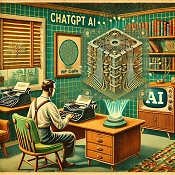Electronics & High Technology Components
- See Full List of AI Topics -
 Computer punched cards were a popular data storage and input medium in early
computer systems. Punched cards were widely used from the 1920s through the 1970s
and played a significant role in the development of computing. Computer punched cards were a popular data storage and input medium in early
computer systems. Punched cards were widely used from the 1920s through the 1970s
and played a significant role in the development of computing.
Computer punched cards were made of stiff cardstock and had rectangular holes
punched in specific positions. These holes represented data and instructions that
could be processed by machines called card readers or tabulating machines.
The most common type of computer punched card had dimensions of 7.375 inches
by 3.25 inches (187.33 mm by 82.55 mm) and featured 80 columns and typically 12
rows of holes. Each column could hold a character or a specific piece of information.
The absence or presence of a hole in a particular column indicated specific data
or instructions.
Programs, data, and instructions were encoded onto the punched cards using keypunch
machines. Operators would use the keypunch machines to punch holes in the appropriate
columns and rows to represent the desired information.
Computer punched cards were used for various purposes, including data entry,
data storage, and batch processing. They allowed for the input and storage of large
amounts of data, such as census information, scientific data, business records,
and more. Programs and instructions were also stored on punched cards, allowing
for sequential execution in batch processing systems.
As technology advanced, punched cards were gradually replaced by more efficient
and versatile storage and input methods, such as magnetic tape, magnetic disk, and
eventually electronic storage. Today, punched cards are considered obsolete, and
their usage has been largely phased out in favor of modern computer systems and
storage media.
Here is a comprehensive review of various
computer
punched card encoding / decoding schemes.
 This content was generated by the ChatGPT
artificial intelligence (AI) engine. Some review was performed to help detect and
correct any inaccuracies; however, you are encouraged to verify the information
yourself if it will be used for critical applications. In some cases, multiple solicitations
to ChatGPT were used to assimilate final content. Images and external hyperlinks
have also been added occasionally. Courts have ruled that AI-generated content is
not subject to copyright restrictions, but since I modify them, everything here
is protected by RF Cafe copyright. Your use of this data implies an agreement to
hold totally harmless Kirt Blattenberger, RF Cafe, and any and all of its assigns.
Thank you. Here are the major categories. This content was generated by the ChatGPT
artificial intelligence (AI) engine. Some review was performed to help detect and
correct any inaccuracies; however, you are encouraged to verify the information
yourself if it will be used for critical applications. In some cases, multiple solicitations
to ChatGPT were used to assimilate final content. Images and external hyperlinks
have also been added occasionally. Courts have ruled that AI-generated content is
not subject to copyright restrictions, but since I modify them, everything here
is protected by RF Cafe copyright. Your use of this data implies an agreement to
hold totally harmless Kirt Blattenberger, RF Cafe, and any and all of its assigns.
Thank you. Here are the major categories.
Electronics & High Tech
Companies | Electronics &
Tech Publications | Electronics &
Tech Pioneers | Electronics &
Tech Principles |
Tech Standards
Groups & Industry Associations |
Societal Influences on Technology
|







